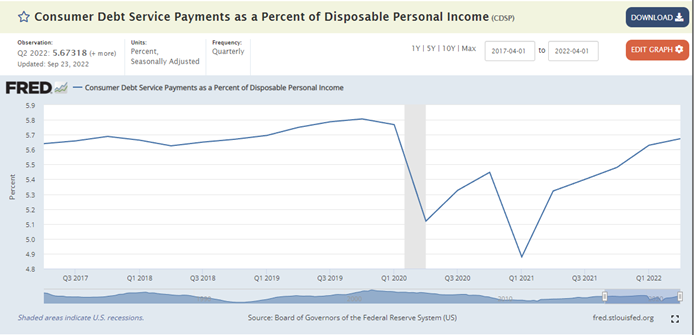England is having a troublesome time adjusting to greater charges – simply Google “UK debt disaster 2022”. It’s admittedly a powerful assertion, however Google works on headlines, and I discover that headlines have a tendency to make use of phrases like that regularly.
Bloomberg, CNN, NY Instances, and so on., are all writing and/or speaking about it, so I gained’t spend a lot time discussing the gritty particulars, however I’d advocate trying into it. It’s fascinating stuff – for funding dorks and non-dorks alike.
Right here’s a Fast Abstract on the UK Debt Disaster: A Gilt-y Second
- The UK authorities introduced broad tax cuts. This implies the federal government will probably must borrow extra to keep up their present spending ranges, particularly since they’re subsidizing greater power prices to assist soften individuals’s ache this winter.
- The rate of interest on 10-year Gilts (UK authorities bonds) spiked on the announcement. Anticipated will increase in future debt ranges for the UK authorities, lead traders to demand greater rates of interest to lend cash to an already indebted nation.
- In 8 days (9/19/2022 to 9/27/2022), 10-year Gilts went from 3.16% to 4.47%. That’s a +41% leap… in 8 days… THAT’S FAST!
- The elevated borrowing prices over such a quick interval, led to liquidity issues throughout the economic system and monetary markets reacted negatively.
- The UK authorities backtracked on their proposal, the prime minister resigned on 10/20/22 after simply 44 days in workplace, and the markets appeared to have calmed down.
Coincidence? Not possible to know, however I feel it’s protected to imagine the monetary markets’ mood tantrum had some affect on the political choices.
I’m longing for a optimistic decision, nevertheless it’s essential to notice that the UK economic system virtually had actual debt issues in a couple of week. All because of the spike in borrowing prices that resulted from proposed fiscal coverage adjustments.
It’s been a recurring theme of mine this 12 months, however all markets appear to be shifting insanely fast.
What can traders do when markets are whipping round like this?
Reply: Clear up your “Monetary Home.” In different phrases, be ready.
Dave Armstrong not too long ago wrote about how monetary market commentary ought to be categorized into certainly one of three buckets: 1. Fascinating, 2. Actionable or 3. Each.
That mentioned, I’d label the UK story as “Fascinating” solely. No portfolio actions to take, however it’s a good reminder about managing your debt prices, particularly in a rising rate of interest surroundings. Charges appear unlikely to return to zero anytime quickly. That assertion isn’t “Fascinating,” everybody appears to know that. However the transition to greater rates of interest does current some “Actionable” gadgets.
Folks, traders, enterprise house owners, and executives have to be ready for quick strikes in monetary markets and guarantee their “Monetary Home” is so as. They have to be financially unbreakable, so if a high-speed transfer happens, they’re prepared.
A couple of good first steps to kick off the “home cleansing”:
- Verify your money ranges and earnings circulation. In case your money reserves are feeling uncomfortable, contemplate replenishing them.
- Evaluate your investments’ long-term objectives/priorities and replace them if obligatory. If they’ve modified, it is best to evaluate your asset allocation to verify it’s nonetheless applicable for you.
- Verify your debt ranges and the price of carrying that debt now that rates of interest are greater. And for those who don’t have a closing payoff plan in your debt, work to create one.
How Customers are Navigating Document Debt Ranges
Let’s give attention to the ultimate bullet level relating to debt. In accordance with the New York Fed’s web site, as of 6/30/2022:
- Complete family debt rose +2% within the second quarter, the biggest improve since 2016.
- Complete debt is now $16.15 trillion with mortgage balances totaling $11.39 trillion of that.
- Bank card balances had been up +13% year-over-year, the biggest improve in additional than 20 years.
I’ve began to listen to some analysts speak concerning the general ranges of client debt. Sure, there’s a whole lot of nominal debt on the market, however that isn’t essentially a horrible factor – even because the Fed stays dedicated to climbing charges and pushing lending prices up.

Should you can service that debt inside longer-term payoff plans, borrowing funds is usually a helpful a part of your wealth plan. Nonetheless, you have to be capable to handle it. Have a look at this 5-year chart from the St. Louis Fed’s web site as of Q2 2022. This exhibits the p.c of client disposable earnings (earnings after tax) that’s getting used to pay their money owed.
Whereas general debt might have grown quickly final quarter, the general servicing of that debt as a p.c of after-tax earnings is about even with pre-pandemic ranges when rates of interest had been close to zero. Fortunately, it seems shoppers have been doing a superb job to date of managing their earnings/money circulation and paying their money owed regardless of rates of interest greater than doubling since mid-March.
Having a Plan is the Greatest Method to Put together
Whereas the UK’s scenario won’t current something “Actionable” from an asset allocation standpoint, it does present a superb reminder to evaluate your debt.
Maintain an additional shut eye in your variable debt (consider bank cards, traces of credit score, margin accounts, and so on.) which may have an even bigger impact on money flows. If rates of interest proceed to extend, variable debt turns into dearer because the borrowing prices go up too. Debt that was beforehand manageable can out of the blue turn out to be unsustainable.
Most significantly be sure you have a plan to payoff that debt. Finally the invoice does come due, and try to be prepared for that point. Should you don’t have a plan, make one, or contact your wealth advisor to debate methods to not solely successfully service, however finally payoff your debt.
Debt is a key piece of your wealth plan and managing it has turn out to be much more essential in a world of upper rates of interest. And it’s very important to be ready when markets are shifting this quick, so that you don’t get caught flat-footed just like the UK virtually did.


